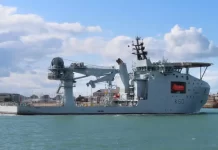
On 21 October Singapore launched its first Multi-Role Combat Vessel (MRCV), Victory, at ST Engineering’s Benoi shipyard. The MRCV is designed to be a mothership for uncrewed systems, with mission modularity, and is the largest ship in the RSN. With higher endurance, payloads and mission flexibility, the MRCV marks a quantum leap in the Republic of Singapore Navy (RSN) capability.
The Minister for Defence, Mr Chan Chun Sing was Guest-of-Honour at the ceremony and Mrs Chan is the Lady Sponsor who formally christened Victory. The ceremony was also attended by the Minister of State for Defence Mr Desmond Choo, Chief of Defence Force Vice Admiral Aaron Beng, Chief of Navy Rear Admiral Sean Wat, and senior defence officials from the Ministry of Defence, the Singapore Armed Forces, and the Defence Science and Technology Agency (DSTA).
Speaking at the ceremony, Mr Chan highlighted that a strong and capable Navy was integral to safeguarding Singapore’s sea lines of communication and ensuring the nation’s security and survival amid an increasingly complex global security environment. He said, “Today, our strategic lines of communications extend much further. That is why we need new capabilities, working together as an integrated SAF, to defend and secure our sea lines of communications, and to make sure that no one with ill intent can disrupt our day-to-day. It is critical to our lives and our livelihoods, and also to the global economy because of the critical geostrategic location that Singapore is in.”
The MRCV combines the combat capabilities of a modern frigate with the carriage and control capacity needed to be a mothership for a wide range of uncrewed systems. Developed to meet the RSN’s unique operational requirements, it is the largest and most complex warship built to date in Singapore. Developed through a joint effort led by the Defence Science and Technology Agency (DSTA), as well as DSO, ST Engineering and international partners.
At 150m in length, maximum speed ~ 22 knots and with a displacement of 8,000 tonnes, the MRCVs will have an operational range exceeding 7,000nm – twice that of the Formidable class frigates. They will have an endurance of over 21 days with a complement of less than 100 personnel. The MRCV weapons fit will comprise a 76mm gun, 30mm remotely-controlled weapon system, MICA and ASTER surface to air missiles and Blue Spear anti-ship missiles.
Uncrewed Surface Vehicles (USVs), Uncrewed Aerial Vehicles (UAVs), and Autonomous Underwater Vehicles (AUVs) deployed from the MRCVs will work together to expand the surveillance and operational reach of the ship across air, surface, and underwater domains. This enables one MRCV, with its fleet of unmanned technologies, to execute missions which would require multiple crewed warships.
The MRCVs will be equipped with advanced sensors and weapons to conduct high-end warfare, and perform the role of Command ship in support of SAF missions. It will also feature the latest Combat Management System (CMS), indigenously developed by DSTA, which incorporates advanced sense-making and decision-support capabilities.
Mission Modularity
Designed to host eight containerised modules in its mission bay, the MRCV can be re-configured for a wide range of missions within short periods of time. This provides increased operational flexibility as it allows the MRCV to also be deployed for missions such as humanitarian assistance and disaster relief (HADR). For example, if the onboard medical capabilities (i.e., Operating Theatre (OT), Intensive Care Unit (ICU), High Dependency Beds, Consultation Room, General Ward, and Pharmacy) are insufficient, the MRCV’s mission bays can accommodate Rapidly Deployable Maritime Containers (i.e. “clinic in a shipping container”) to increase its capabilities for HADR missions.
The capability to handle standardised shipping containers also streamlines logistics for the ship. Food, stores and maintenance equipment can be loaded and unloaded safely and efficiently. Beyond the flexibility that modular capabilities provide, the MRCVs are also built with significant growth margins:
- The high-voltage electrical distribution system – the MRCV’s “grid” – needed to power its Integrated Full Electric Propulsion (IFEP) system – is designed to accommodate future systems which may have higher energy demands.
- The superstructure is made from lightweight composite material. This enhances ship stability by lowering the centre of gravity and provides additional weight margins to accommodate the insertion of new equipment.
The MRCV is also designed with advanced automation to enhance crew effectiveness and safety.
- The MRCV’s Bridge can be operated by two crew instead of five, and the Engineering Control Centre only requires one crew instead of four to monitor ship systems.
- Onboard cranes streamline the process of loading/unloading of supplies, weapons, equipment. The Mission Bays are also fitted with a cargo elevator as well as equipment for efficient internal movement of containers.
Six MRCVs will replace the existing Victory-class Missile Corvettes (MCVs), and will be delivered progressively from 2028 onwards. The MRCVs will retain the name and pennant numbers of the existing Victory class MCVs. “This upholds the proud heritage and history of those ships which similarly represented a quantum leap in the RSN’s capability when they entered service in the 1990s.”
Sources: RSN & Singaporean MINDEF



